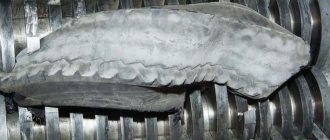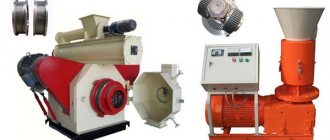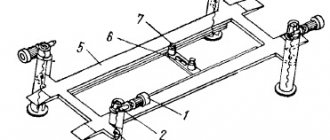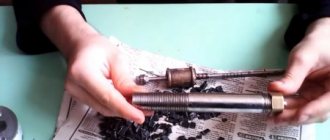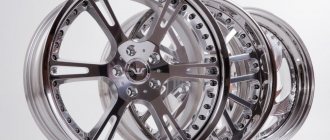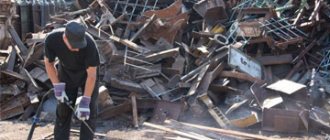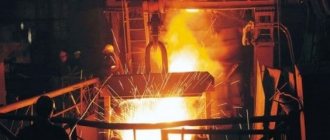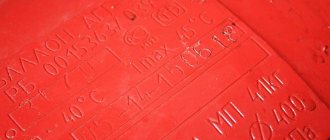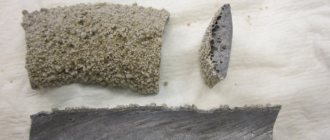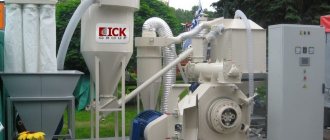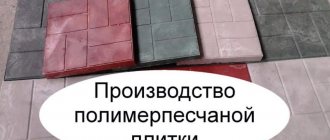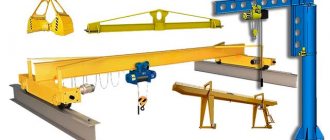Tire material composition
A tire consists of many materials that differ in their physical and chemical properties.
- Steel - the cord and spikes are made from it.
- Hydrocarbons are artificial rubber with a carbon black filler.
- Sulfur in vulcanizing additives.
- Synthetic thread - cord is also made from it.
- Chlorine-containing hydrocarbons in the adhesive.
Harmful substances such as arsenic and lead are not added to modern tires.
Car tire
In order to completely recycle all these various substances and not cause damage to the environment, designers and technologists have developed several technological processes and installations that serve them.
Example of production organization
Let's consider an enterprise that processes tires into fuel (fuel oil) using a SHAH pyrolysis plant with a capacity of 5 tons. According to its technical characteristics, up to 400 kg of pyrolysis liquid should be obtained from one ton of raw materials.
To start a business you will need an investment of 4.6 million rubles:
- Purchase of a pyrolysis unit “SHAH” - 3,000 thousand rubles.
- Hydraulic scissors - 300 thousand rubles.
- A tank with a capacity of 10 thousand liters – 220 thousand rubles.
- Tools, consumables - 280 thousand rubles.
- Delivery, installation, commissioning - 300 thousand rubles.
- Other expenses (coordination, connection to electrical networks) - 500 thousand rubles.
With an operating mode of 30 shifts per month and 100% equipment utilization, the installation produces 60 tons of products.
The properties of the resulting pyrolysis oil correspond to heating oil. The average wholesale cost of this fuel is 9,500 rubles per ton (current price as of 02/12/2013).
With this option, monthly revenue will be 570,000 rubles, the net profitability of the activity is 50%. The return on investment at 100% line load will be 16 months, and at 50% load 32 months.
Tire pyrolysis
The simplest reuse process is to use waste tires as fuel. Recycling tires by burning them in the open air or in furnaces is unacceptable, since open combustion produces a lot of air pollutants and substances harmful to health.
Diagram of the pyrolysis installation
Therefore, combustion is carried out in pyrolysis plants in two stages.
At the first stage, under conditions of lack of oxygen at high temperatures (up to 500 ° C), materials decompose into pyrolysis gas, liquid hydrocarbons, soot and solid metal residues. With the correct settings of the process parameters, from one ton of feedstock the following is obtained:
- 0.5 tons of liquid hydrocarbons that can be purified to obtain usable gasoline;
- 200 kg of gas used to heat the pyrolysis unit;
- 200 kg of soot (carbon);
- 100 kg of steel.
Pyrolysis gases contain sulfur and silicon oxide.
Tire pyrolysis plant
The soot resulting from the process is unfortunately highly contaminated with chlorine and sulfur compounds, as well as extremely toxic dioxins. It is impossible to use it as a raw material for carbon production. Cleaning from harmful impurities is too expensive. Disposal of such waste is possible only with the support of government environmental programs for the recycling of car tires and other hazardous waste.
Solid fuel
Solid fuel obtained from waste is characterized by low cost and high calorie content. The combustion of such fuel causes much less damage to the environment compared to the combustion of traditional coolants, and there is practically no waste left. In addition, processing waste into solid fuel helps preserve natural resources - brown and hard coal, petroleum products, wood.
Therefore, advanced recycling enterprises are increasingly replacing the combustion of solid waste with the production of solid fuel from it. It is more economically profitable.
How to make solid fuel from garbage at home
The easiest material to recycle and the most suitable material to use is paper. Even if you don't subscribe to newspapers, you probably receive a lot of junk mail, outdated documents, bills and other waste paper. If you save up all this paper, you can turn it into a useful product with little effort. Cardboard from unnecessary boxes will also come in handy.
- Grind the starting material well. An office shredder is best suited for these purposes - you don’t have to tear the paper with your hands or cut it with scissors.
- Place the trimmings in a bowl and fill with warm water.
- Use your hands to crush the paper to make a paste. An industrial or even a regular kitchen blender will cope with this task even better.
- Wait 10-12 hours, then strain the paper through a sieve or squeeze it by hand.
- Pour the mixture into the mold and press well to remove any remaining water and form a briquette.
- Place the mold in a warm place to dry for a few days before removing the briquette.
The resulting briquettes can be used for a fire at a picnic, for a fireplace or a home stove. They are lightweight, burn much longer than regular paper, and provide a lot of heat.
Grinding tires to obtain rubber crumbs
The recycling principle is very simple. Tires are crushed on special equipment for processing tires into crumbs in several stages, the resulting product is sorted, and at the output of the production line three materials are obtained:
- metal in the form of small wire scraps;
- rubber crumb;
- cord thread trimmings.
The process of turning tires into crumbs
In this case, no chemical changes occur in the materials, and all harmful compounds remain in a bound, stable state, and no new ones are formed. Processed products can be safely stored and transported.
If metal waste can be easily separated from crumb rubber, then certain technical difficulties arise in isolating from its composition a polymer thread that is similar in chemical and physical properties.
Therefore, budding entrepreneurs in environmentally oriented businesses work, as a rule, with purely metal-cord tires. Tire Recycling Machine The main problems they face are:
- Selecting a location for installing equipment.
- The alternative between erecting a new building or adapting an existing one.
- Selection, purchase and installation of machines for tire processing.
- Registration of permits for the disposal of car tires.
- Development of sustainable supply channels for raw materials and sales of the final product.
The simplest machine for processing tires is not that expensive, but it has limited productivity and the size of the processed raw materials. The use of other grinding methods removes these limitations, but increases the cost of the line.
Tire composition and difficulty of recycling
The main material of a car tire is rubber. It is made from natural or synthetic rubber. The latter is most often used, since it is cheaper and is not inferior in quality to natural material.
To increase the strength and wear resistance of tires, carbon black or soot is added to them. In some cases, sulfur is used instead. These substances are needed to hold the mixture together at the molecular level.
Another alternative to soot is silicic acid. It provides good traction between the wheels and the road, but makes them less wear-resistant.
The rubber part of the tire is called the tread. Underneath there is a metal frame and a textile or plastic cord. High fabric content makes recycling more difficult. It gets clogged into machines, and after grinding it makes it difficult to magnetize metal particles from the mixture. If you select textiles, elastic and metal separately, it will take much longer.
Equipment for processing tires into crumbs
This group of equipment is designed for grinding raw materials into crumbs and dividing them into fractions with subsequent shipment for further processing.
Vibrating screen for sorting
A typical set of equipment for tire recycling includes:
- Group of shredders (shredder, hydraulic shears, tape cutter).
- Waste separators (magnetic and vortex).
- Conveyors for moving raw materials.
- Vibrating sieves for sorting.
- Equipment for packaging and loading of products.
- Low-power pyrolysis plant for burning textile waste.
The price of such a turnkey line starts at 10-15 million rubles. However, it is not necessary to purchase all equipment from one brand. Using locally produced machines and devices with similar technical characteristics (or simply those already available) you can save significantly.
Before purchasing, be sure to visit a similar operating enterprise and find out from them the problems and bottlenecks when using this or that equipment.
The most important component of the production line will be the shredders. Their smooth and uninterrupted operation largely determines the production and financial success of the enterprise.
Tire recycling begins with a shredder, which cuts tires into fragments no larger than 15-20 cm in size. It bears the maximum load, so it would be wise to take care of a good service contract and a supply of spare parts.
Tire Shredder
If the planned output exceeds a ton of tires per hour, it is better to choose a multi-roll plant made in Europe. Its high-quality work will facilitate the functioning of equipment located further in the technological chain.
Rotary knife crushers and cam extruders are used as secondary crushers. Extruders are inexpensive to purchase, but come with high operating costs for electricity and replacement of failed cams.
Conveyors, separators and vibrating sieves are simple in design and do not have such highly loaded and critical parts. Many local manufacturers produce such tire recycling equipment at affordable prices, while maintaining high quality products.
Pyrolysis plant for recycling tires into fuel
This method of recycling tires involves burning them in an airless space at a temperature of 500-1,000 degrees. As a result you can get:
- coke;
- gas;
- liquid fuel.
The metal cord remains intact and goes for further melting. The average yield of liquid fuel is 40% by weight of the raw material.
Tire recycling and burning equipment includes:
- Loading chamber;
- Combustion chamber;
- A condenser in which gas is converted into fuel.
The technology allows you to change the type of pyrolysis and ultimately obtain more gas or coal. This ensures waste-free and environmentally friendly production. The resulting gas is reused in the installation and no harmful substances are released into the atmosphere.
Chinese-made pyrolysis plants are popular. But they have significant disadvantages:
- instructions and documentation are often in Chinese, without translation;
- difficulty ordering spare parts;
- installation does not comply with the stated characteristics.
Fuel production line
From a business point of view, becoming a pure fuel producer is profitable and prestigious.
The energy potential of one ton of tires is approximately equal to the potential of a ton of coal. But there is a big problem standing in the way of the successful use of waste tires: the toxicity of combustion products. They contain sulfur dioxide, dioxins and other highly toxic compounds.
Tire to fuel processing line
Burning over an open fire is unacceptable; in the case of a pyrolysis installation, the issue of processing toxic waste remains. The installation will have to install expensive treatment facilities. With them, the process can become profitable provided that at least 110 tons of raw materials are processed per day. Investments will pay off rather slowly. Most of these installations were built with government support or with government participation.
There is another technological process. In plants of this type, tires are processed into fuel. The complex requires about 20 m2 for installation, its height is 10 m. Metal rims are removed from former tires, crushed into crumbs and loaded into a chemical reactor using a conveyor. It maintains an operating temperature of 460 °C. Under such conditions, rubber breaks down into liquid hydrocarbons, pyrolysis gas, solid soot deposits and metal scraps. This gas is used to maintain the temperature in the reactor; its excess, in small quantities, is released into the atmosphere after passing through the purification system.
Liquid fractions are poured into containers through a dosing system and taken to a warehouse. Soot waste (carbon black) is cooled, quenched and metal is separated on magnetic separators. Metal, carbon and waste are also packaged and sent for sale and disposal.
Such a system processes up to five tons of tires into fuel per day. This gives:
- liquid fuel fractions - up to 2 tons;
- metal waste - up to 0.5 tons;
- solid carbon-containing residues - up to 1.5 tons;
- gas - up to 1 ton.
The tire recycling line is installed outdoors under a canopy and requires a level area with a hard surface. Production maintains a continuous work cycle and requires two operators per shift to operate. Electric power - up to 15 kW. Air and industrial wastewater purification systems will also be required.
Oven operation
The operating method of an industrial pyrolysis plant for processing rubber products and tires involves several main production stages:
- Preparation of material for its further decomposition in a retort.
- The resulting raw material during pyrolysis is fed into a device for cooling and partial condensation of the pyrolysis gas.
- When passing through the condensing pipeline, the final separation into liquid and gaseous components occurs.
- When the remaining gas is dried, it is supplied for further combustion in a furnace.
Large processing plants use additional catalyst units in the rubber decomposition process.
In such equipment, pyrolysis raw materials are distilled into various fuels; these installations require large areas and sufficient funding.
In our country, the method of technological rubber processing is not yet widely used, but worthy examples of domestically produced plants are available on the market.
Working Process of Pyrolysis Tire Recycling Plant:
The raw material is fed into the reactor using a manual or automatic feeder, then the main furnace can be heated. When the temperature rises to the appropriate level, the same will produce petroleum gas and enter the gas separator. Heavy oil gas will liquefy and enter the heavy oil tank, while light oil will rise in the oil condenser and be compressed in the oil tank. Non-liquefied flammable gas enters a hydraulic seal for desulfurization and removal of impurities, then it can be recirculated to heat the reactor. When the pressure is too high, another part of the gas will burn to reduce the pressure.
1:automatic feeder 2:shell 3:reactor 4:heavy oil tank 5:oil condenser 6:oil tank 7:hydraulic seal 8:combustion chamber 9:blower 10:automatic material release system 11:flue condenser 12:dust collection system 13:induced exhaust fan 14:water tank 15:cooling tower
Find out the price
After all fuel oil production is completed and discharged, the reactor must be cooled. When the reactor temperature drops by 40 degrees, the soot will be released automatically. If the raw material is a whole busbar, please at least less than 50 degrees to remove the wire from the reactor using a hook. It may leave some exhaust gases, please remove after meeting emission standards. Please ensure all work is completed before processing the next batch.
